Introduction
Leadership has attracted people’s attention for centuries. Historical narratives are filled with stories of military, political, social, and religious leaders who have significantly impacted historical events.
However, effective leadership is not confined to these grand images. Every leader is different, and so is their leadership style. But is it something they inherit genetically? No.
A leader’s style isn’t formed in a vacuum. It is shaped and influenced by various factors like personality, experience, values, skills, and beliefs. Not just that, external factors like an organization’s work culture can also impose a huge impact on its directive style.
“Being a great leader means recognizing that different circumstances may call for different approaches.” – Daniel Goleman, a psychologist
Leaders with the best results do not rely on only one leadership style; they use most of them seamlessly and in different measures, depending on the business situation.
In this article, we discuss 9 effective leadership styles of leadership and how they affect performance and results. We will also be discussing their pros and cons and when a manager should adapt to a certain kind of leadership.
What is a leadership style?
A leadership style is a leader’s characteristics and behavioral method in approaching their team and participating in crucial decision-making processes. It is the degree to which they direct, motivate, manage, and inspire them to work towards goals and accomplish objectives.
Leadership styles play a crucial role in developing organizational strategy, implementing business plans, and introducing teamwork and employee engagement. Effective leaders adapt and respond to stakeholder expectations, workplace conflicts, and market changes while ensuring employee well-being.
What is the best leadership style?
If you are looking for an answer to the above question, the answer is “No one in particular.”
You can’t just pick one leadership style and claim it to be the best. Instead, you can choose a blend of multiple kinds and assess what best matches your strengths and brings the best out of your leadership persona.
Below take a closer look at each of the leadership styles, and know when to use them by understanding their pros and cons.
1. Bureaucratic leadership
The bureaucratic style of leadership relies on a strict hierarchy, defined roles, clear rules, and procedures to perform specific tasks or procedures. Everyone is expected to follow a clear chain of command and not be asked to question authority.
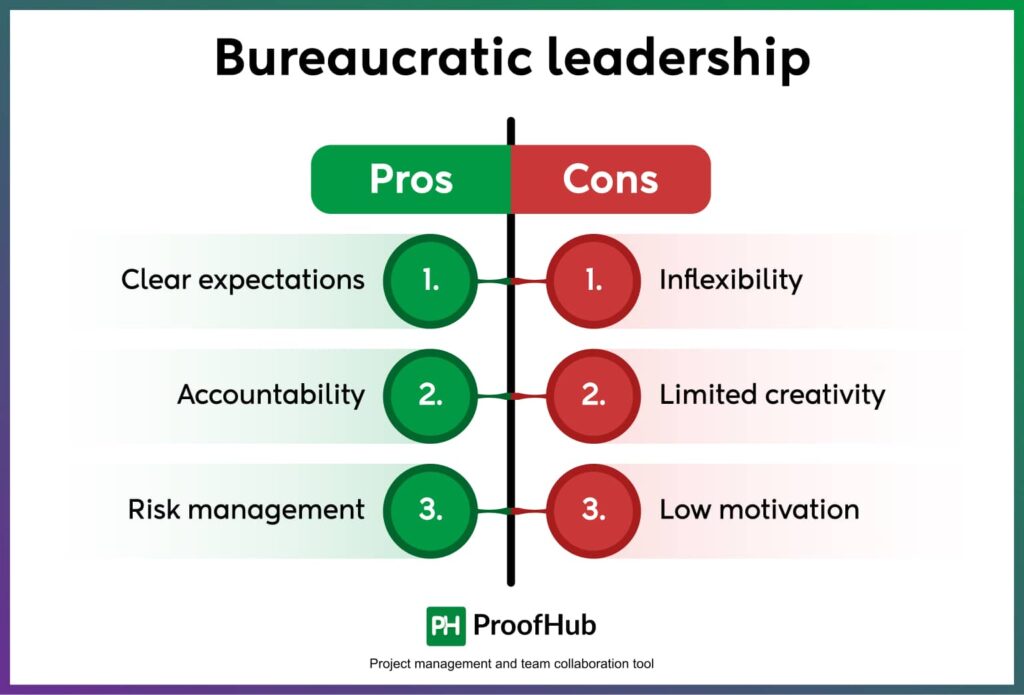
Pros of bureaucratic leadership
- Clear expectations: Clear expectations as team members understand their roles, responsibilities, and expectations. This helps reduce their confusion thus increasing efficiency.
- Accountability: As it is easy to see who is responsible for what so this makes them accountable for all their actions and decisions.
- Risk management: Reduces risk as each team member follows strict rules and regulations.
Cons of bureaucratic leadership
- Inflexibility: The emphasis on rigid rules leads to inflexibility and the scope for experimentation and innovation.
- Limited creativity: Strict adherence fails to encourage new ideas or innovation.
- Low motivation: Employees feel disengaged and de-motivated due to a strict work environment leading to a lack of opportunities for personal input or growth.
When to use bureaucratic leadership
Bureaucratic leadership is ideal for work environments with complex structures or work settings that require consistency and strict adherence to procedures such as:
- Government agencies and public sector organizations.
- Large corporations with complex operations.
- Industries with stringent regulatory requirements such as healthcare, finance, and manufacturing.
2. Autocratic leadership
The autocratic leadership style, also known as authoritarian or coercive leadership, considers themselves in the commanding position. These are the leaders who make decisions themselves or with their trusted groups and do not prefer to take input from their teams. They idealize the “My way or the highway.” approach.
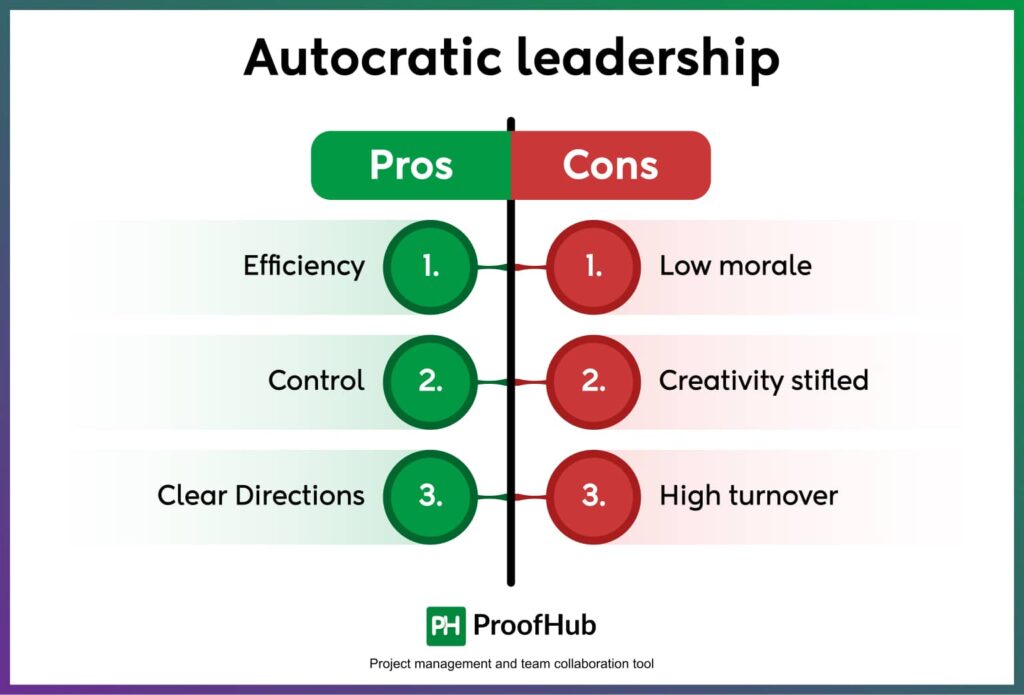
Pros of autocratic leadership
- Efficiency: The decision-making is quick and efficient.
- Control: The strategies are carried out with effective focus for timely project completion.
- Clear Directions: This leadership style is effective in crisis situations or with inexperienced teams as they have clear instructions and expectations.
Cons of autocratic leadership
- Low morale: These leaders may turn into micromanagers or be completely aloof.
- Creativity stifled: Lack of contribution hinders their creativity and innovation.
- High turnover: Employees feel undervalued, leading to high turnover rates.
When to use autocratic leadership
Autocratic leadership can be effective in situations where quick and decisive action is required such as:
- Construction or manufacturing.
- Military operations.
- Production.
3. Democratic leadership
The democratic leader, also known as the participative or facilitative leader, not only offers guidance but listens and respects team input and feedback. In fact, they invite the team’s views, opinions, and ideas and show trust and empathy in them before making a final call. Contrary to autocratic and bureaucratic leadership, this is the most easygoing leadership style.
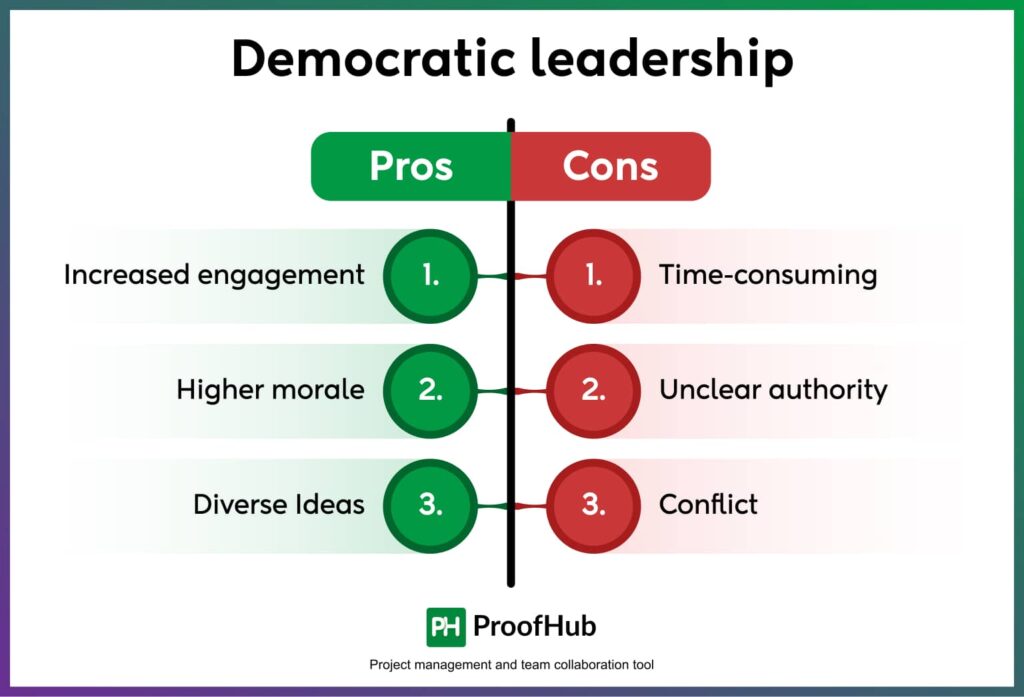
Pros of democratic leadership
- Increased engagement: Motivation, empowerment, and job satisfaction accompany this sort of management.
- Higher morale: Innovation and creativity flourish in a collaborative environment, increasing employee retention and morale.
- Diverse Ideas: Employees are more likely to be committed, and engaged when they have a say in decisions.
Cons of democratic leadership
- Time-consuming: Reaching a consensus can be time-consuming. It is not recommended for virtual teams in cases where urgent decisions require immediate action.
- Unclear authority: As roles and responsibilities become unclear, this leads to confusion, chaos, and delay.
- Conflict: Difference in opinion often leads to conflict and misunderstanding between team members.
When to use democratic leadership
Initially, Google’s founders, Larry Page and Sergey Brin, adopted this leadership style that led to innovation and collaboration, resulting in Google’s success. Democratic leadership is best used in situations where decisions do not involve revealing private or confidential information.
- Private businesses to schools.
- Government bodies.
- Some of the largest corporations in the world, including Coca-Cola, Apple, and Google.
4. Laissez-faire leadership
Laissez-Faire is a French word meaning “let them do.” This passive form of leadership, also known as delegating or hands-off leadership, involves leaders taking a step back and allowing team members to make decisions and solve problems independently.
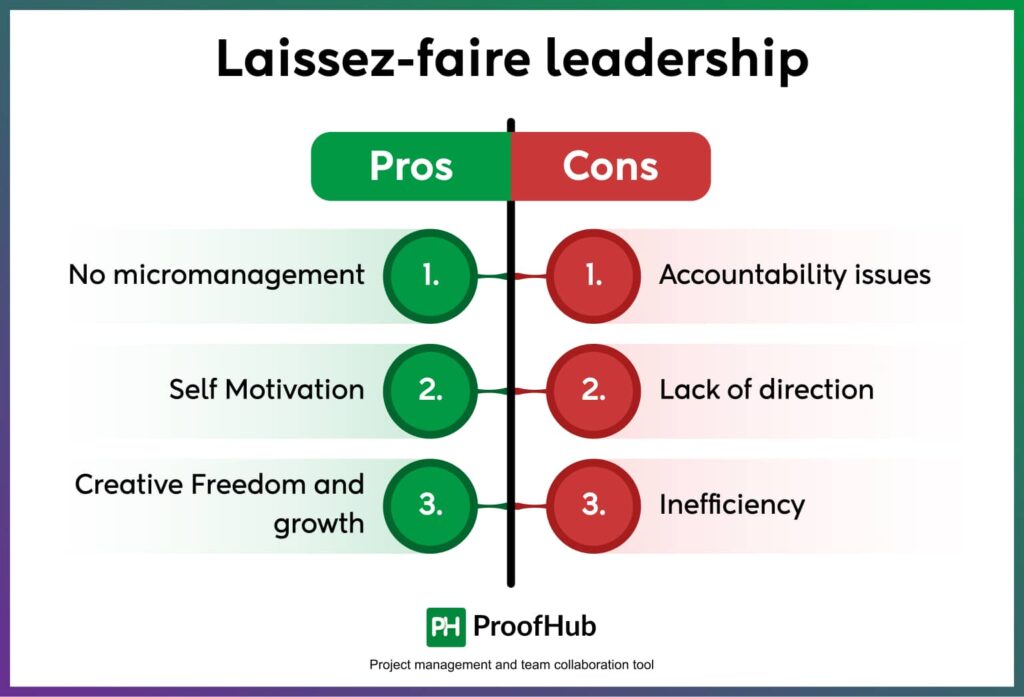
Pros of Laissez-Faire leadership
- No micromanagement: There is no micromanagement involved in this style of leadership leading to stress stress-free and relaxed culture ultimately increasing employee job satisfaction.
- Self Motivation: Encourages team members to be self-driven and motivated.
- Creative Freedom and growth: Employees can develop their problem-solving and decision-making skills.
Cons of Laissez-Faire leadership
- Accountability issues: Rifts and misunderstandings arise due to unclear roles and responsibilities.
- Lack of direction: Lack of guidance and expectation can lead to degrading motivation and performance.
- Inefficiency: High potential for inefficiency and missed deadlines due to lack of oversight.
When to use laissez-faire leadership
Laissez-faire leadership is best used with employees who are already skilled and self-motivated and require zero to little supervision.
- Tech industries.
- Advertising & Entertainment.
- Retail buying.
5. Transformational leadership
In this style of leadership, leaders, and followers help each other to advance to a higher level of morale and motivation. Leaders do not totally discard the organization’s hierarchical structure and programs, but in fact, strengthen them by working within structure and policies to build and expand new ones and collapse old ones.
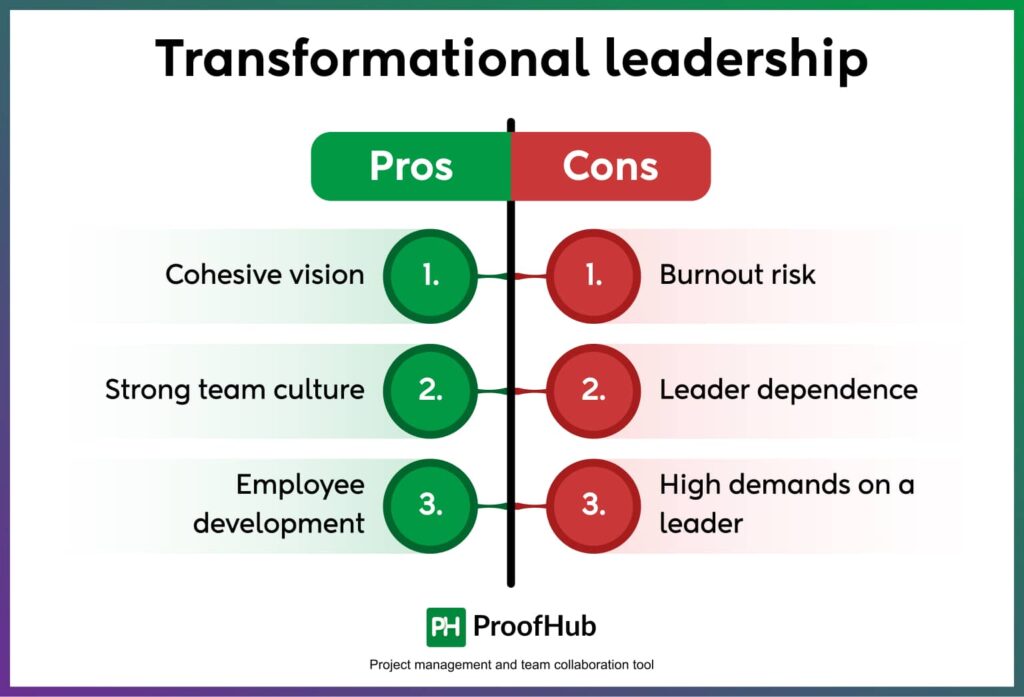
Pros of transformational leadership
- Cohesive vision: Everyone is working cohesively towards a shared direction and vision.
- Strong team culture: There is a strong sense of team culture.
- Employee Development: Encourage employees to reach their full potential.
Cons of transformational leadership
- Burnout risk: It is easy to feel burnout because of persistent pressure.
- Leader dependence: A leader is the center figure requiring constant involvement during implementation.
- High demands on a leader: Maintaining constant motivation and inspiration all the time can weigh heavily on a leader’s capabilities.
When to use transformational leadership
This type of leadership is best suited to organizations undergoing significant change, fostering innovation, or prioritizing employee development.
- Entertainment.
- Automobile.
- Technology.
6. Transactional leadership
Transactional leadership places emphasis on a rigid structure or rules that when violated are met with punishments or corrective actions. These leaders use structure as motivators, relying on the desired effect that performance produces rewards, working within the organizational framework, and following the status quo. They tend to react to problems rather than proactively seek creative solutions, emphasizing adherence to established norms and processes.
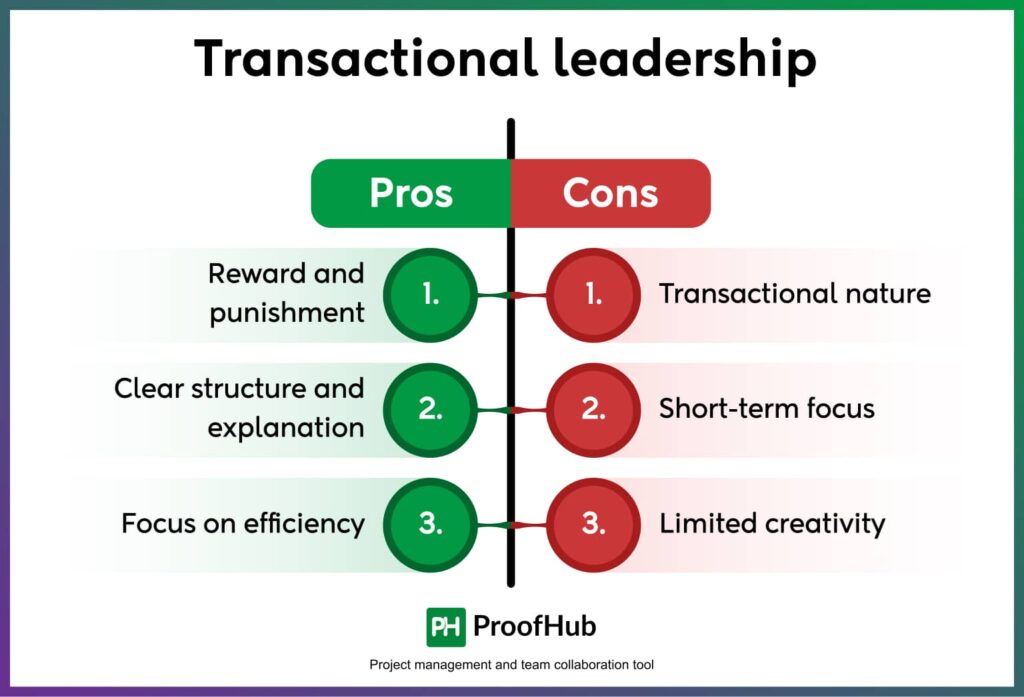
Pros of transactional leadership
- Reward and punishment: There is a clear structure of rewards and punishments. They use corrective actions like reprimands or penalties for poor performance, incentives, or recognition for good performance.
- Clear structure and explanation: Transactional leaders set clear goals, rules, and guidelines for their followers.
- Focus on efficiency: A large emphasis is placed on maintaining efficiency in operations and achieving specific outcomes.
Cons of transactional leadership
- Transactional nature: May lead to transactional relationships where followers perform only to receive rewards, rather than their motivation to perform.
- Short-term focus: There is a huge emphasis on immediate goals, which can undermine long-term objectives.
- Limited creativity: No flexibility in implementing creative solutions for successful task completion.
When to use transactional leadership
Transactional leadership can be used in environments where tasks are well-defined and immediate performance improvement is needed
- Manufacturing companies.
- Sales operations.
- Customer services.
7. Servant leadership
Servant leadership style, in simpler words, is a leader that puts his team’s interests, aspirations, and needs over anything else. It is a selfless management style prioritizing the team’s professional growth over theirs. Servant leaders follow a serving mindset and do not impose power. Employee satisfaction and fulfillment play a crucial role in measuring the effectiveness of this leadership style.
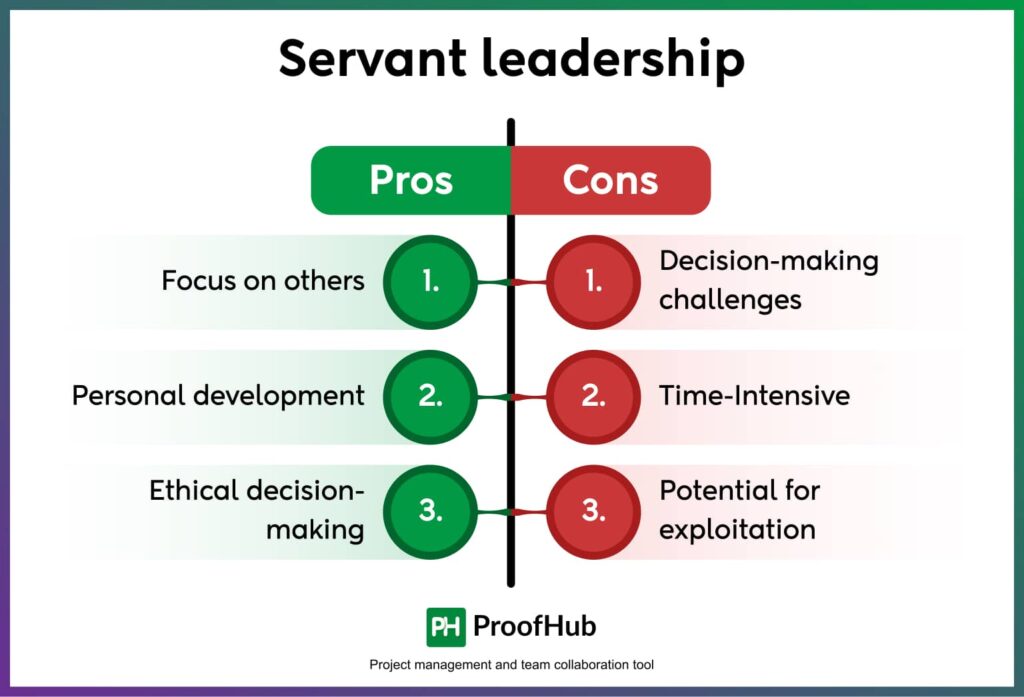
Pros of servant leadership
- Focus on others: By prioritizing the needs of their team members, this leadership style fosters a supportive and empowering environment.
- Personal development: Promotes personal growth and development without occupational burnout.
- Ethical decision-making: Encourages ethical decision-making and behaviors that benefit the wider community.
Cons of servant leadership
- Decision-making challenges: One can easily lose sight of long-term objectives when serving employee well-being first.
- Time-intensive: Demand a considerable amount of time and effort to build relationships and support individual development, which may be challenging in fast-paced environments.
- Potential for exploitation: Employees may consider leaders overly lenient and may take them for granted.
When to use servant leadership
Servant leadership can be used in environments where emphasis is given to nurturing and empowering others to foster a positive organizational culture, such as
- Healthcare.
- Education.
- Hospitality.
8. Pacesetting leadership
In this style of leadership, leaders set high standards for themselves and their team members, expecting excellence and achievement of goals. Here leaders are the key players in increasing the efficiency and productivity of their teams. This approach sets a tone for the team to work at optimal productivity to obtain high-quality outcomes. If they don’t see things going as per expectations, they don’t hesitate to step in for successful execution.
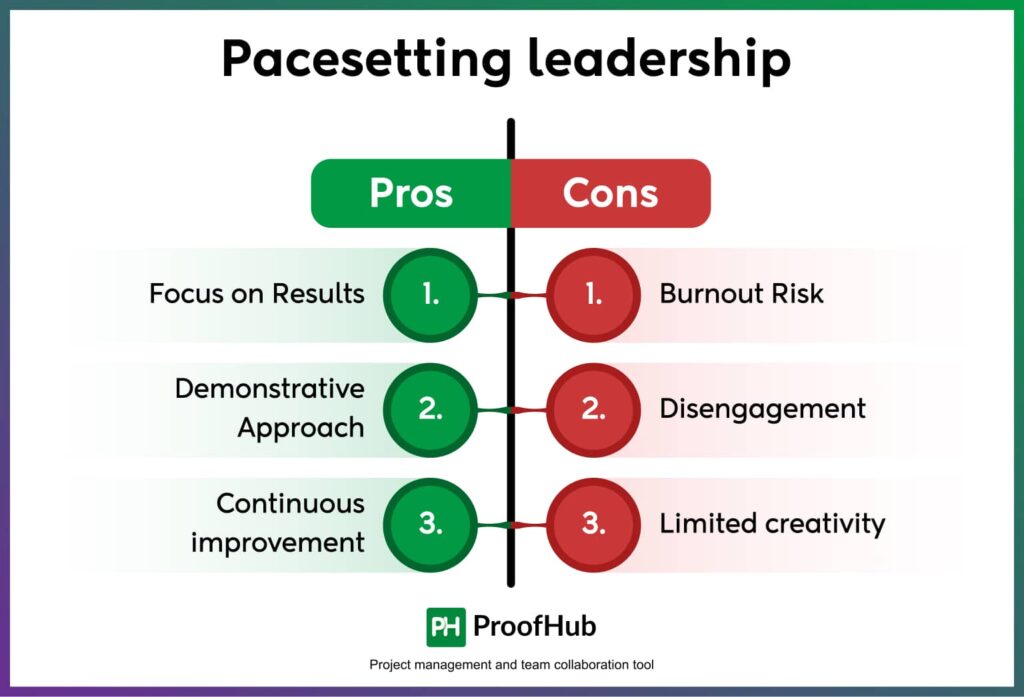
Pros of pacesetting leadership
- Focus on Results: Emphasize achieving results quickly, with a strong focus on measurable outcomes.
- Demonstrative Approach: Leading by example, they demonstrate the desired standards of performance and behavior.
- Continuous improvement: Encourages continuous learning and improvement among team members to maintain high standards.
Cons of pacesetting leadership
- Burnout Risk: Team members can feel frustrated with the constant intervention by their leader.
- Disengagement: Rushed deadlines and extreme focus on results can compromise project quality.
- Limited creativity: Limited feedback or coaching can stifle creativity.
When to use pacesetting leadership
Pacesetting leadership can drive high performance and rapid results and is suitable for environments where ambitious goals, efficiency, and focus on measurable outcomes are crucial for success, such as
- Sales.
- Finance.
- Technology.
9. Coaching leadership
Coaching leadership or conscious leadership brings a coach out of a leader. Their major aim is to identify and nurture team members’ strengths individually while aligning their efforts for goal achievement. They understand the fine line between providing support and micromanaging. Once they are confident in their capabilities, they give them the full autonomy and trust to proceed. They prioritize improvement over perfection.
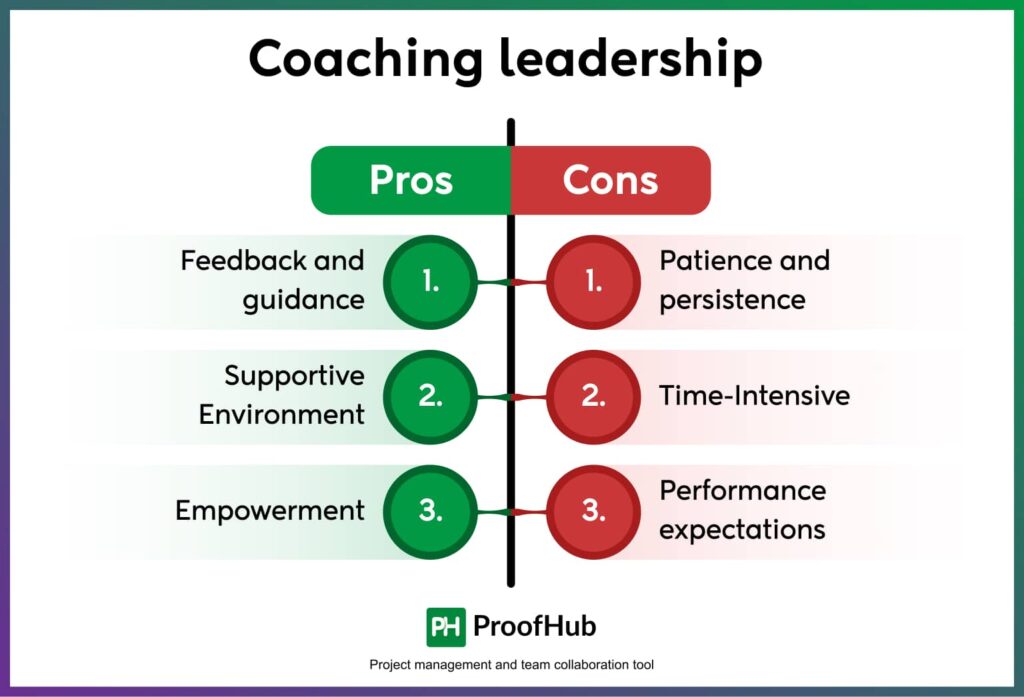
Pros of coaching leadership
- Feedback and guidance: Providing concrete and constructive feedback helps employees to refine and improve.
- Supportive Environment: It creates a supportive, motivating, and collaborative environment.
- Empowerment: By nurturing talent, they prepare future leaders.
Cons of coaching leadership
- Patience and persistence: Expect a lot of patience and persistence due to changes and improvements in performance that take time to manifest.
- Time-Intensive: Requires significant time and effort from leaders, which may be challenging.
- Performance expectations: Balancing development coaching style with performance expectations can be challenging, as leaders need to ensure both individual growth and achievement of organizational goals.
When to use coaching leadership
Coaching leadership is particularly effective for organizations where collaboration and teamwork are essential for achieving complex goals or delivering high-quality services such as
- Healthcare.
- Professional services.
- Education.
- Technology.
Conclusion
Effective leadership is all about adaptability rather than rigidity.
Leadership is an ever-evolving journey of tackling challenges head-on and innovatively solving them. Leaders adjust their style to what situations and circumstances demand of them. They mix and match styles to enhance sustainability and bring out the best.
While the benefits of different leadership styles are clear, it is important to recognize their potential drawbacks and their impact on shaping organizational culture.
Read more similar articles:

